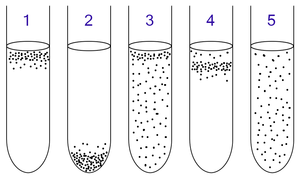Thioglycolate broth is a multipurpose, enrichment, differential medium used primarily to determine the oxygen requirements of microorganisms. Sodium thioglycolate in the medium consumes oxygen and permits the growth of obligate anaerobes.[1] This, combined with the diffusion of oxygen from the top of the broth, produces a range of oxygen concentrations in the medium along its depth. The oxygen concentration at a given level is indicated by a redox-sensitive dye such as resazurine that turns pink in the presence of oxygen.

1: Obligate aerobes need oxygen because they cannot ferment or respire anaerobically. They gather at the top of the tube where the oxygen concentration is highest.
2: Obligate anaerobes are poisoned by oxygen, so they gather at the bottom of the tube where the oxygen concentration is lowest.
3: Facultative anaerobes can grow with or without oxygen because they can metabolise energy aerobically or anaerobically. They gather mostly at the top because aerobic respiration generates more ATP than either fermentation or anaerobic respiration.
4: Microaerophiles need oxygen because they cannot ferment or respire anaerobically. However, they are poisoned by high concentrations of oxygen. They gather in the upper part of the test tube, but not the very top.
5: Aerotolerant organisms do not require oxygen as they metabolise energy anaerobically. Unlike obligate anaerobes, though, they are not poisoned by oxygen. They can be found evenly spread throughout the test tube.

This allows the differentiation of obligate aerobes, obligate anaerobes, facultative anaerobes, microaerophiles, and aerotolerant organisms. For example, obligately anaerobic Clostridium species will be seen growing only in the bottom of the test tube.
Thioglycolate broth is also used to recruit macrophages to the peritoneal cavity of mice when injected intraperitoneally.[3] It recruits numerous macrophages, but does not activate them.[3]
References
edit- ^ Cain, Donna. "Fluid Thioglycollate [sic] Broth". Collin College.[dead link]
- ^ Cheesbrough, Monica (2006). District Laboratory Practice in Tropical Countries, Part 2. Cambridge University Press. p. 126. ISBN 0-521-67631-2. Retrieved 2009-09-14.
- ^ a b Leijh PC; van Zwet TL; ter Kuile MN; van Furth R (November 1984). "Effect of thioglycolate on phagocytic and microbicidal activities of peritoneal macrophages". Infection and Immunity. 46 (2): 448–452. doi:10.1128/iai.46.2.448-452.1984. PMC 261553. PMID 6500699.